Volume 5, Number 1 - January
2000
Journal of the Home Metal Shop Club of Houston,
President - Keith Mitchell, V. Pres.- John Lilly, Treasurer - Gordon
Lawson, Secretary - Dean Eicher
Editor - Email kmitchl@wt.net
Membership Information Membership is open to all those interested in
machining metal and tinkering with machines. The purpose of the club is
to provide a forum for the exchanging of ideas and information. This includes,
to a large degree, education in the art of machine tools and practices.
There is a severe shortage of written information that a beginning hobbyist
can use. This makes an organization such as this even more important. For
membership information and forms, call Keith Mitchell at the phone numbers
shown at the above.
Notes from the President
By: Keith Mitchell
First issue of the new Millennium!
Moving the meeting location didn't seem too traumatic. I have not heard
from anyone who went to the wrong location. George Carlson said he counted
44 at the meeting. We had speculated during the business meeting there
would be a small turnout due to the holidays. The previous location would
not have accommodated this crowd. My overall opinion of the new location
was that it meets our needs, available and free, but has a few undesirable
features. I felt the lighting was less than adequate and the HVAC noise
made it difficult to speak and be heard by everyone. At the next meeting
I would like to try setting up the room with the audience facing South
toward Pinemont. Perhaps this will solve some of the problems with white
noise. For a writing surface I am suggesting we buy a roll of white paper
and tape up pieces at the start of the meeting. We can use markers like
we did in the December meeting. The consideration in doing this is that
the markers not bleed through the paper and on the wall.
Following the last meeting Don Foster had invited me to see his mobile
display of engines. Don has spent 30 years putting together a number of
engines that are organized to show chronologically the development of that
technology through time. His display is mounted on a trailer and can be
powered by an air compressor. It's quite an impressive display. Don has
agreed to bring it to one of our meetings this spring when the weather
is more conducive to outdoor activities.
At the last meeting we passed out cards to collect the information for
the Suppliers List. Please fill these out and bring to the next meeting
starting with your most obscure supplier and working to the better known
sources. Keep in mind that we do not plan to distribute this information
outside the club so your "secret" sources are protected.
At the next meeting we will be taking photos of all of the members.
These will go into the Member Handbook.
Finally, I would like to ask for everyone's cooperation in conducting
meetings. I think it's great that everyone is interested and enthusiastic
about what we are doing. I would like to keep our meeting format as informal
as possible, however, we have grown to the point that we need to exercise
a little restraint during the meetings so everyone has the opportunity
to hear what's going on. In particular I would like to ask everyone to
refrain from carrying on side bar conversations when someone is trying
to address the group. Presentations take the presenter's time to prepare.
Please pay them the courtesy of your undivided attention when they are
addressing the group. If you have something to add, please be recognized
by the speaker and address the group. Please hold any other business until
after the meeting.
December Meeting Minutes
By: Dean Eicher
Chips Meeting - 1:00 P.M. December 18, 1999, Collier Library
Attendance - 41, One first time attendee
In the Chips Meeting, the following activities took place.
1. Feature Presentation - J. D. Wise talked work-holding for
the lathe. He mentioned the traditional 4 jaw chuck, adjust true 3 jaw
chuck, fixture plates and collets. While many styles of collets are available,
5C collets are the most popular for lathes because they are available in
more than 100 round sizes, as well as square and hex shapes. Disadvantages
of 5C collets include limited grip range(collapse range of 0.005")and a
lever gripping action(the collet tends to hinge at the end of the slots,
resulting in a strong grip only at the end of the collet). J. D. mentioned
that other types of collets such as ER single angle and Double Angle collets
overcome the problems with the 5C collets, but accept only round work or
tooling. Other work holding devices mentioned included tapered mandrels,
expanding mandrels, magnetic chucks, faceplates, temporary adhesives on
faceplates, cathead for irregular work, and other specialized chucks.
2. Don Foster - brought a piece of sponge iron and told us about
the ancient method of layering coke, lime, and iron ore in a hole in the
ground and making iron.
3. Dick Kostelnicek - brought a countersink he made of the type
with a hole at 45( through the cone.
4. John Korman - talked about using castable refractory for
insulating the sides of a foundry. He brought castings for a lathe milling
attachment he made.
5. Gerald Farek - brought an air motor powered display case
drilling machine he made. He told us about the aluminum extrusions he used
and how the addition of a nylon bearing plate made a good light-duty linear
bearing. Gerald also showed a wood carousel Aloris tool holder rack he
made.
6. Doug Blodgett - brought a worn out gib from his milling machine
and a nicely scraped replacement he made. He used carbide scrapers and
used a diamond wheel to sharpen the scrapers.
7. Joe Williams - brought a chrome plated T-handle chuck wrench
he made from salvaged chrome plated rod.
8. Dennis Cranston - brought a picture of a three axis computer
controlled milling machine he made. He showed a wax block that he machined
the letters HMC in.
Foundry Group Notes
By Keith Mitchell
The last meeting of the foundry group was attended by about 20 members.
A number of people brought show and tell items. Dennis Cranston brought
a sample of Petrobond. Dick Kostelnicek brought crucibles, crucible tongs,
a pouring shank, and molding flask. There were some conversations about
sources for scrap aluminum and brass. Old engine pistons were identified
as a good source for castable aluminum alloy.
Bill Kimbrough offered to donate a crucible furnace to the club. His
only reservation is if the club ever disbands, the furnace be returned.
>From his description it sounds like it would be large enough for anything
we might pour. If the issues listed below can be overcome, I feel this
is a good solution. If I own a furnace personally it might be used twice
per year. With a club owned furnace the utilization would I suspect be
significantly better. We should be able to have a better set up and develop
some expertise with in the club on making castings. Joe Williams has offered
a 125# propane bottle to fuel the furnace. Doug Blodgett is checking with
the Live Steamers to see if we can store and operate the furnace at their
facility at Zube Park in far west Harris County. We also discussed mounting
the furnace on a trailer so it would be transportable.
This proposal was put out to the members via e-mail. All of the responses
I received were positive. The issues identified around this are:
1. Liability. Handling molten metal
and operating a furnace does entail some inherent risk.
2. Equipment Care. We don't want
to spend the time to get a nice casting operation set up only to find that
every time we try to use it he previous user has failed to properly care
for it or has not returned all of the equipment. To get past this scenario,
I suggest that we enlist several people, four or five, one of whom will
be present at each furnace operation. They will oversee the operation to
make sure safety practices are strictly followed and the equipment is properly
cared for and managed so it is ready for the next use and any consumable
are reordered as they are used. We may want to investigate sending one
or two people to a school or seminar and have them return and educate the
others.
3. Consumable supplies. I propose
that the club provide the furnace, fuel, molding sand, parting powder,
and degassing tablets. The members would each provide their own crucible
tongs, crucibles, pouring shank, flask, and ingots.
These issues will be discussed at the next foundry group meeting. If
you have input to this and can not be there please contact me.
The Ceramic Store was identified as a good source for furnace materials,
burners, refractories, etc.
Gordon Lawson has done some research on sources for castable refractory.
He has identified Able Refractory Products, 5220 Texas St., Houston, Texas
77011, (713) 926-9623, as a possible source.
They have two products which may be suitable:
3400 F - can withstand direct contact with iron - "Carton" 100 lbs.
$93.00; Full Pallet of 36 (3600 lbs) @ 1760/ton $3168 per pallet ($88.00/carton)
Coverage: 170 lbs/cu.ft.
3000 F - 75lb bag $26.00; Full pallet of 48 (3600 lbs) @ $583/ton $1049.40
per pallet (21.87/bag) Coverage: 145 lbs/cu.ft.
December Meeting Photos
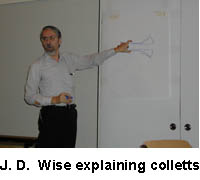 |
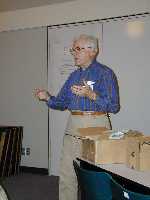 Don Foster
explaing the early iron smelter operations Don Foster
explaing the early iron smelter operations |
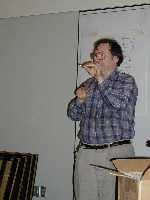 Kostelnicek
Dick showing his shop made countersinks Kostelnicek
Dick showing his shop made countersinks |
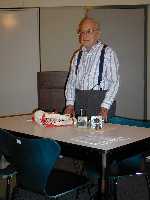 John Korman
with his lathe milling attachment made from home foundry castings. John Korman
with his lathe milling attachment made from home foundry castings. |
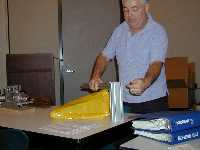 Jerry Farek
with the aluminum extrusion building system Jerry Farek
with the aluminum extrusion building system |
|


 Don Foster
explaing the early iron smelter operations
Don Foster
explaing the early iron smelter operations Kostelnicek
Dick showing his shop made countersinks
Kostelnicek
Dick showing his shop made countersinks John Korman
with his lathe milling attachment made from home foundry castings.
John Korman
with his lathe milling attachment made from home foundry castings. Jerry Farek
with the aluminum extrusion building system
Jerry Farek
with the aluminum extrusion building system